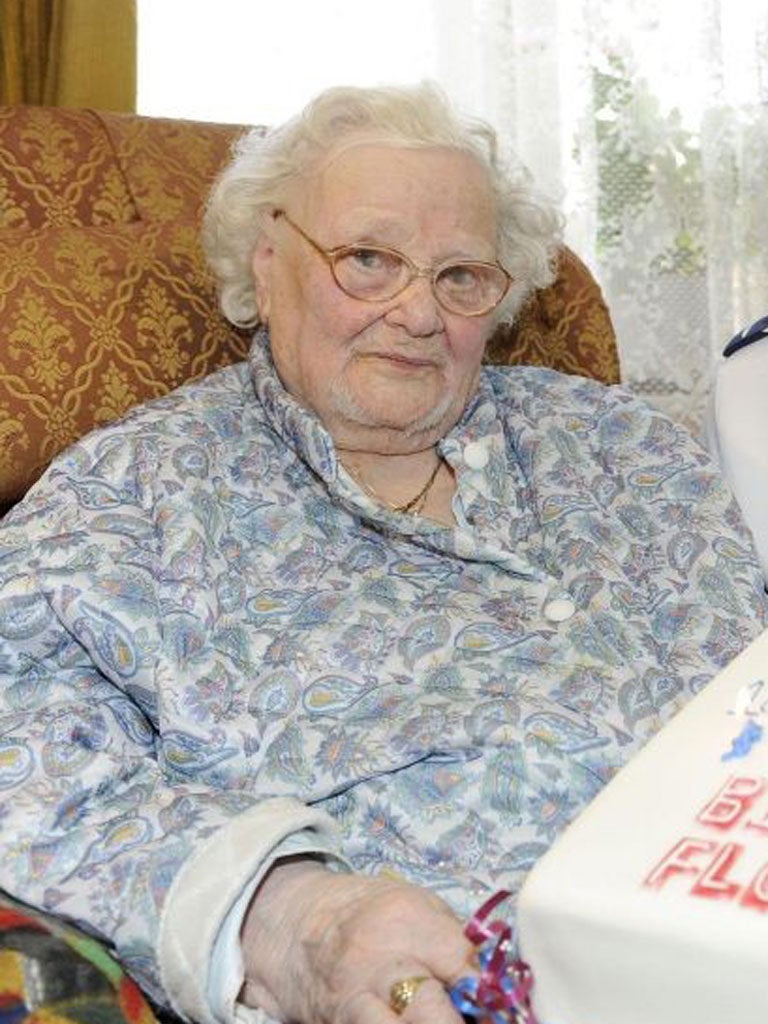Florence Green: Veteran of the First World War

Your support helps us to tell the story
From reproductive rights to climate change to Big Tech, The Independent is on the ground when the story is developing. Whether it's investigating the financials of Elon Musk's pro-Trump PAC or producing our latest documentary, 'The A Word', which shines a light on the American women fighting for reproductive rights, we know how important it is to parse out the facts from the messaging.
At such a critical moment in US history, we need reporters on the ground. Your donation allows us to keep sending journalists to speak to both sides of the story.
The Independent is trusted by Americans across the entire political spectrum. And unlike many other quality news outlets, we choose not to lock Americans out of our reporting and analysis with paywalls. We believe quality journalism should be available to everyone, paid for by those who can afford it.
Your support makes all the difference.Florence Green, who has died aged 110, was the last known surviving veteran of the First World War, serving with the Women's Royal Air Force at airbases in Norfolk.
Although she saw no action, Green was one of the 25,000-strong army of women who volunteered for the WRAF. Founded in April 1918, shortly before the end of the war, the WRAF was intended to provide women mechanics in order to free men for active service, due to the horrific casualty rates and the severe personnel shortages at military establishments.
However, the organisation was overwhelmed by the response, with women volunteering for positions as drivers, cooks, office clerks and factory workers as well as filling other wartime needs. Initially, they were based in Britain, but later about 500 women served in France and Germany.
Aged 17, Green enlisted in September 1918, two months before the Armistice, and worked briefly at RAF Narborough, which had been opened in May 1915 to defend against Zeppelin raids, and then at RAF Marham in Norfolk. As a stewardess in the officers' mess, she recollected the officers as "perfect gentlemen", adding, "It was very pleasant and they were lovely. Not a bit of bother. They kept us on our toes and there was no slacking."
Green admitted meeting "dozens of pilots" with whom she went on dates. "I had the opportunity to go up in one of the planes [a Sopwith Camel] but I was scared of flying." Serving three meals a day, she worked "every hour God sent", though she did make a number of good friends. "In many ways, I had the time of my life," she recalled.
When the Armistice was declared on 11 November 1918, Green witnessed what was undoubtedly the most benign bombing of the war, with fliers from Marham celebrating by attacking RAF Narborough with bags of flour, whereupon the Narborough fliers retaliated by bombing with bags of soot. Green left the service the following July and the WRAF was disbanded in April 1920.
Retired Air Vice-Marshal Peter Dye, Director-General of the RAF Museum, said it was fitting that the last survivor of the first global war was someone who had served on the home front. "In a way, that the last veteran should be a lady and someone who served on the home front is something that reminds me that warfare is not confined to the trenches," Dye said. "It reminds us of the Great War, and all warfare since then has been something that involved everyone. It's a collective experience... warfare touches all of our lives."
Florence Beatrice Patterson was born in London in 1901 and grew up in Edmonton before moving to King's Lynn in Norfolk, where she would remain. After the war she met Walter, an army veteran who served in both world wars, and was a railway porter. They married in 1920 and had three children. Green worked for much of her life at a hotel in King's Lynn and in her spare time was heavily involved with the Royal British Legion, knitting clothes and toys for children. She crocheted blankets for children at the local Queen Elizabeth Hospital until her nineties.
Green's wartime experience was unheralded until 2009, when the Lynn News and Advertiser noted her 108th birthday. The article alerted Andrew Holmes, a British researcher for the Gerontology Research Group, a US-based organisation that keeps statistics on centenarians. He traced her service records using the National Archives, resulting in Green's recognition as a veteran the following year.
"It's a common misconception that a veteran must be someone who saw action or fighting in the trenches," he said. "A veteran is someone who served in one of the armed forces, regardless of their role – a medic, an ambulance driver or a waitress – they all count."
Last May the only living male First World War combat veteran, the British-born sailor Claude Choules, died in Australia at 110, while Britain's last survivor from the trenches, Harry Patch, known as "The Last Tommy," died in July 2009 at the age of 111. Green is survived by her three children, (May, 90, Bob, 85 and June, 76), four grandchildren and seven great-grandchildren.
Florence Beatrice Patterson, First World War veteran: born London 19 February 1901; married 1920 Walter Green (died 1970; two daughters, one son); died King's Lynn 5 February 2012.
Join our commenting forum
Join thought-provoking conversations, follow other Independent readers and see their replies
Comments